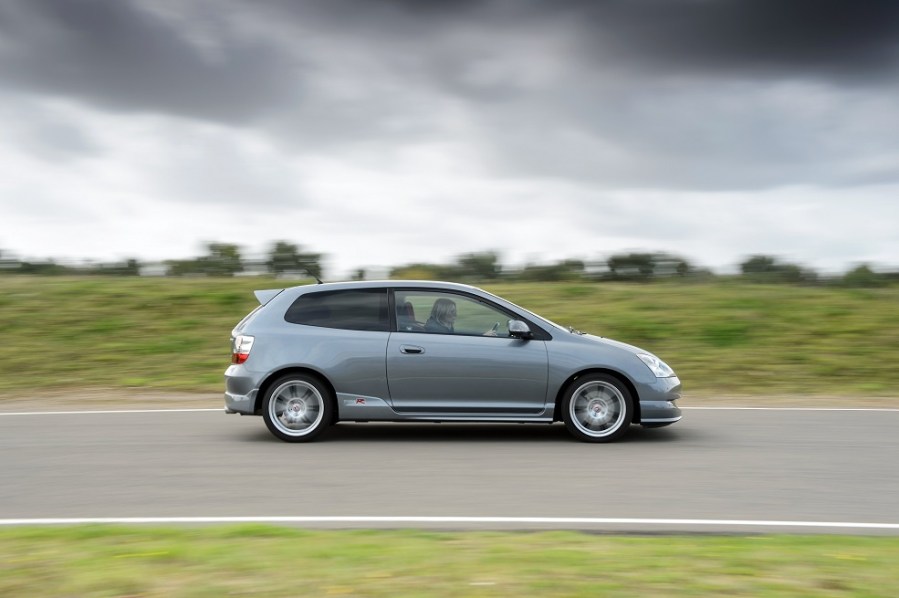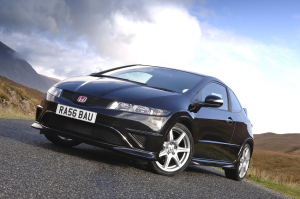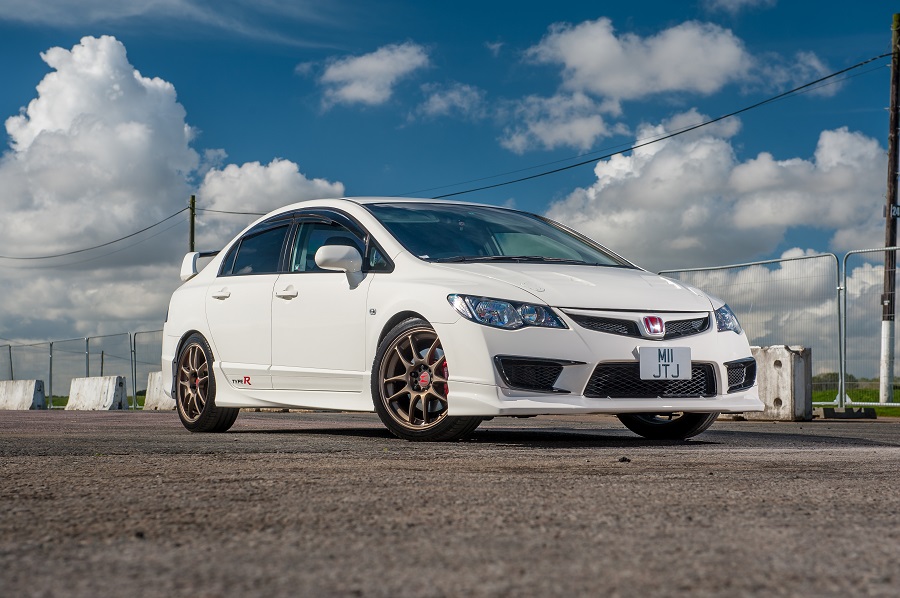Looking for your next hot hatch? Here’s our Honda Civic Type R buyer’s guide, covering every generation available on the second-hand market!
Best known for their love-them-or-hate-them VTEC engines, the Honda Civic Type R is a hugely popular vehicle to modify, across all of its iterations. These little front-wheel drive pocket rockets are bundles of fun even in stock form, and have plenty of untapped potential locked away. Luckily, the aftermarket is more than happy to release those extra performance gains, if you wish to chase them.
So, if you’re looking for a relatively affordable, sporty car that’s still fairly practical, you can’t really go wrong with a Type R.
Want to know which Civic Type R is right for you and your budget? Well, look no further. Whether you’re interested in the high-revving, early naturally aspirated models, or the modern 300PS+ turbocharged ‘super hatches’, we’ve got them all covered here.
Read on to find out about each car’s strengths and weaknesses, as well as how much you can expect to pay for one.
Honda Civic Type R EK9 Buyer’s Guide

The EK9 Civic Type R is nothing less than an icon. Built within the site at Suzuka circuit (Japan’s motorsport heartland), there should be no doubts about its legitimacy as a performance car, despite whatever its humble exterior might tell you.
This JDM-only special edition of the Civic underwent a serious weight-saving regime, including having all of its sound-deadening removed. On top of that, the car’s chassis was seam-welded to improve rigidity, and therefore stability, at high speed. And then, there was the engine. Codenamed ‘B16B’, this 1.6-litre four-pot block was unique to the EK9 Type R. It would quickly go on to develop a mighty reputation, thanks to its hugely charismatic VTEC cam profile shifting, giving the car a very noticeable sudden burst of energy at the 6200rpm-mark.
It produced near-comical output figures of 182bhp & 118lb ft of torque at 8200rpm and 7500rpm respectively, meaning that this car was all about the top end of its lofty rev range. That gave the impression that this engine wanted to be driven at maximum, all of the time. If you did, you were bound to be pleasantly surprised. When launched, the B16B was the most powerful engine per liter in the world, and when planted under the hood of a car that weighed just over 1000kg, the results were nothing short of addictive.
Unless you’re based in Japan, you’ll probably need to import an EK9 from its homeland if you want to get your hands on one. Prices start at around $15,000 / £12,000 for ropey examples, and stretch all the way up towards the $30,000 / £25,000-mark. When you consider the sort of prices that other JDM favorites are demanding these days, that actually seems fairly reasonable.
Pros of the Honda Civic Type R EK9
- High-revving, VTEC-equipped B16B engine
- Lightweight, with fun handling
- A real collector’s item
Cons
- Potential for rust
- Weak engine mounts
- Very rare outside of Japan
Common Problems
- Sticking rear calipers
- Smoke from the exhaust (valves seals or piston rings)
- Leaking rear light seals
For some more detailed advice about this car, read our dedicated Honda Civic Type R EK9 buyer’s guide. We’ve also got a tuning guide for the EK9, if you’re planning to modify it.
Honda Civic Type R EP3 Buyer’s Guide

The EP3 might have been built in Swindon rather than Suzuka, but that doesn’t mean it’s lacking any of the qualities you’d expect from the ‘Type R’ badge.
Designed for the mass market across Japan and Europe, the EP3 is a little less hardcore than the EK9, but still features Honda’s trademark VTEC crossover zone and fun front-wheel drive handling. One fairly major change, however, was the introduction of the K20A engine in place of the B16B. Slightly more emissions-friendly by nature, the K20A was still nevertheless just as receptive to mods, if not more so. As such, K20s are some of the most commonly tuned engines around.
Although still quite affordable, EP3 prices are beginning to rise (like pretty much everything else). That said, you can still pick up a decent example from around £5500. Aside from the pristine exceptions, the EP3 market tops out at around £9000-£11,000. Though, bear in mind, Japanese-market models are often more expensive than their European equivalents, as they have extra goodies such as a stock LSD.
The American market never received the EP3 Type R, and as they first started to roll off the production line in 2001, they aren’t yet exempt from the 25-year import rule either. So, if you want to bring one of these modern classics stateside, you’ll have to wait a few more years yet .
Pros of the Honda Civic Type R EP3
- Playful handling
- Well supported by the European & Japanese performance aftermarket.
- Relatively affordable
Cons
- Potential for rust, especially on facelift models
- Stock 200PS output might feel a little underpowered today
- Plenty of poorly-kept examples on the market
Common Problems
- Stretched timing chain
- Worn steering rack
- Worn seat bolsters
For some more detailed advice about this car, read our dedicated Honda Civic Type R EP3 buyer’s guide. We’ve also got a tuning guide for the EP3, if you’re planning to modify it.
Honda Civic Type R FN2 Buyer’s Guide

The FN2-gen Civic Type R was met with a rather lukewarm reception upon launch. First, people were largely underwhelmed by its soft, unsporting looks. Critics were given more firepower when it was announced that the car had also gained a solitary extra horsepower over the EP3, while weighing between 60-100kg more depending on spec. If that wasn’t enough, the car’s rear suspension had also been made *less* sophisticated.
For those reasons, many people consider the FN2 to be the runt of the Civic Type R litter. However, if you forget its predecessors for a minute and simply judge the car on its own merit, then it must be said that the FN2 is still a hugely capable hot hatch. More than that, it represents fantastic value for money.
Despite being a newer car, the FN2 starts at a very similar price point to the EP3 – around £5500 – while the top end of the market tends to hover around the £7000-£9000 range. This is assuming you aren’t looking for a Mugen 200 variant, which demands north of £15,000. If you want the full fat Mugen FN2 Type R, you’ll need to budget at least £40,000 if you manage to find one of the 20 models.
Pros of the Honda Civic Type R FN2
- Playful handling, despite internet reputation
- The most affordable Civic Type R of them all
- Last of the naturally-aspirated breed
Cons
- Bulkier body, less sophisticated suspension than the EP3
- Controversial styling hampers visibility from inside
- Paintwork susceptible to wear
Common Problems
- Timing chain
- Valve clearances
- Gearbox synchro issues
For some more detailed advice about this car, read our dedicated Honda Civic Type R FN2 buyer’s guide. We’ve also got a tuning guide for the FN2, if you’re planning to modify it. For some inspiration, check out our FN2 Big Build!
Honda Civic Type R FD2 Buyer’s Guide

Launched at the same time as the FN2, this sedan-based alternative emerged from Suzuka for Japan’s eyes only. Given the differences between EUDM and JDM-spec EP3 Civics, it’s clear that Honda felt that Japanese buyers could handle – and more importantly, truly wanted – a more hardcore hot hatch than us over here in the UK. So, rather than just building an even hotter FN2, the Japanese branch of Honda took a more drastic approach. Instead, they’d go on to develop an entirely fresh performance car, based on an entirely different platform.
The resulting FD2 Type R was a big hit in the domestic market – 13,000 were sold in Japan, compared to 11,000 FN2 sales in the UK. And for good reason. On paper (and in practice) the FD2 is simply a more attractive proposition than its European counterpart. The FD2 has a higher 11.7:1 compression ratio and produces 225PS at 8400rpm, and has greater torque levels too. As a result, it takes just 6.3 seconds to reach 62mph from a standstill, and will climb all the way to 149mph.
On top of that, its larger wheelbase gives the FD2 more stability through corners, which is handy considering how much the responsive steering eggs you on to push it further. There are loads of other goodies thrown into the mix too: drive-by-wire throttle control, larger brakes with Brembo 4-pot calipers, and a torque sensing helical limited-slip diff, to name just a few. Oh, and if that deal wasn’t sweet enough already, it even features independent rear suspension – rather than the FN2’s much-criticized torsion beam.
Too extreme?
It’s not all sunshine and roses though. For British & European roads, the stock suspension is arguably too firm to be somebody’s daily driver. They’re expensive too – you’re looking at around £19,000 for a good one (roughly twice the cost, if not more, of an equal condition FN2). That’s partially because of the ‘JDM mystique’ and genuine performance credentials, but also partly because they’re simply hard to get your hands on in this part of the world. Oh, and if you’re based in the States, hard luck – these aren’t legal to import yet.
Pros of the Honda Civic Type R FD2
- Noticeably sportier than an FN2 when stock
- Will earn you a shed load of street cred
- Improved practicality of a four-door
Cons
- Overinflated price tag
- Harsh suspension set-up for everyday driving
- Scarce in the West
Common Problems
- Timing chain
- Valve clearances
- Gearbox synchro issues
Want to learn more about the elusive FD2 Type R in detail? Check out our head to head feature, where we pitch it against one of the best FN2s in the country.
Honda Civic Type R FK2 Buyer’s Guide

By the time the FK2 arrived in 2015, the hot hatch landscape had changed quite a lot. Turbocharging was now the standard, and that meant that the ultra-revvy nature of the earlier non-turbo generations was lost.
Still, what the FK2 lacks in sound, it more than makes up for in performance. The first Civic model to breach the 300 horsepower mark, the FK2 was launched with 310PS up its sleeve as standard. As such, it elevated the Civic Type R brand up to a whole new level of speed, requiring Honda to equip the car with fancy anti-torque steer suspension knuckles.
Given the lesser age and higher performance potential of these cars, the FK2 naturally warrants a slightly higher price tag. £20,000 is the sort of number your looking at for an average example, with the best of the bunch demanding up to £25,000. Sadly these cars were never officially brought to the US, so if you’re looking to import one, hard luck, they aren’t legal yet.
Pros of the Honda Civic Type R FK2
- 310PS from the factory
- Seriously quick, surprisingly economical if you behave
- Relative exclusivity (only 2-year production period)
Cons
- Muted engine tone compared to earlier cars
- Lacquer problems on wheels and calipers
- Quite pricey as a result of scarcity
Common Problems
- Head gasket failure & Overheating
- Loss of boost pressure
- Gearbox issues
For some more detailed advice about this car, read our dedicated Honda Civic Type R FK2 buyer’s guide. We’ve also got a tuning guide for the FK2, if you’re planning to modify it.
Honda Civic Type R FK8 Buyer’s Guide

If the EK9 was considered a serious performance car, then it’s only fair that the FK8 gets the same label. In its regular guise, this loudly-styled hatchback managed to get around the Nürburgring in just 7:43.8 minutes. How? Well, it’s equipped with 320PS and weighs just 1380kg, translating into a top speed of 169mph (in a Civic!), and a 0-62mph time of 5.7s.
In fairness, the FK2 isn’t far off those stats either, though it’s fair to say that the FK8 takes the model’s sporting credentials up a further notch. What’s more, it manages to do all of this without being an utter nightmare to commute in. Overall, FWD bases don’t come much better than this.
Interested in buying one? Prices start at around £22,000 in the UK and rise to £35,000 for super low-mileage examples. There are a few special editions that demand north of 50 grand too, but unless you’re a collector or a die-hard Civic fan, we wouldn’t advise spending that much. As for our Stateside readers, the FK8 was the first generation of Honda Civic Type R to make it into North America officially. As a result, FK8s tend to be a bit more expensive. $28,000 is the rough starting point for FK8s in the US, but it’s not uncommon to see them listed for as much as $45,000-$50,000 at the top end. Mind you, that’s nothing compared to the dealer mark-ups on the all-new FL5…
Pros of the Honda Civic Type R FK8
- One of the best FWD performance cars ever
- Global availability and aftermarket support
- Aggressive aero?
Cons
- Muted engine tone compared to early N/A cars
- Sensitive to alignment
- Aggressive aero?
Common Problems
- Second-gear grind
- Infotainment system crashes
- Brake rotors/discs cracking
For some more detailed advice about this car, read our dedicated Honda Civic Type R FK8 buyer’s guide. We’ve also got a tuning guide for the FK8, if you’re planning to modify it.
The post Honda Civic Type R Buyer’s Guide appeared first on Fast Car.
Leia Mais.